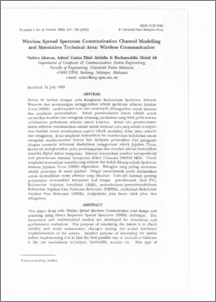Citation
Khatun, Sabira and Abdalla, Ashraf Gasim Elsid and Mohd Ali, Borhanuddin
(2002)
Wireless Spread Spectrum Communication Channel Modelling
and Simulation Technical Area: Wireless Communication.
Pertanika Journal of Science & Technology, 10 (2).
pp. 269-286.
ISSN 0128-7680
Abstract
This paper deals with Wireless Spread Spectrum Communication Link design and
planning using Direct Sequence Spread Spectrum (DSSS) technique. The theoretical and mathematical models are developed for simulation and performance evaluation. The purpose of simulating the system is to check validity and avoid unnecessary changes during the actual hardware implementation of the system. Another purpose of simulating the system before implementing it is to find the best possible way or method to fabricate
it like the modulation technique, bandwidth, security etc. This type of communication link gives the ability to prevent other external sources from
jamming and interfering with the transmission of information due to the use of Direct Sequence technique. This paper describes the design, development
and simulation of an indoor digital wireless communication channel. The communication channel consists of a transmit-receive unit operating in the 900-915 MHz frequency range. For a reliable and secure wireless communication
link, the Direct Sequence Spread Spectrum (DSSS) technique is used. The most challenging part is the receiver where the pseudo-random noise sequences must be synchronized to successfully recover the original transmitted message.
Other key areas of investigation include selection of the pseudo-random noise code (P code), Amplitude Shift Keying (ASK), Differential Binary Phase Shift Keying (DBPSK) modulation/demodulation, Differential Phase Shift Keying (DPSK) modulation, coherent versus non-coherent detection, etc.
Download File
![[img]](http://psasir.upm.edu.my/style/images/fileicons/application_pdf.png)  Preview |
|
PDF
Wireless_Spread_Spectrum_Communication_Channel_Modelling.pdf
Download (4MB)
|
|
Additional Metadata
Actions (login required)
 |
View Item |

